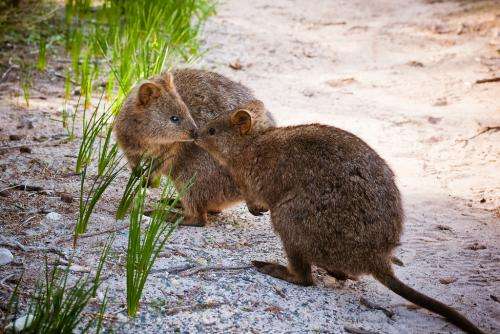Quokka 'pellets' best determiner of population abundance

Resesarchers have put a method of estimating animal population size to the test—and found counting a species' faecal matter is the most accurate way to sum up their abundance quickly—at least with quokkas.
The study investigated the accuracy of the Liddelow rapid survey technique, an existing method that has been widely adopted by land managers, to estimate the population of quokkas (Setonix brachyurus) throughout the south-west of WA.
Co-author and UWA PhD student Karlene Bain says quokkas are a threatened species in the southern forests and to manage them effectively, an understanding of their abundance and occupancy is fundamental.
"The Liddlelow rapid survey technique of providing a qualitative measure of relative abundance by assessing indicators of activity such as faecal pellets, runnels, tracks and sightings is very subjective," she says.
"The approach is potentially providing a false picture of the conservation status of the species as it tends to overestimate the abundance of quokkas due to its inability to differentiate between old and new activity."
"As quokkas are quite mobile within the landscape of the southern forests, counting all of the faecal pellet groups including all of the old ones that have accumulated over time could result in an overestimation of the species."
"Furthermore, if the quokkas are moving between habitats, land mangers may end up with an indication that there are a lot more habitats occupied than what there actually are."
Instead, the researchers attempted to refine the Liddlelow rapid survey back to a quantitative method by testing individual components of the technique such as the numbers of runnels, tracks, and faecal pellet groups at 12 sites between Manjimup and Walpole.
Faecal pellet counts correlated very strongly to the population abundance of quokkas and performed better than the composite Liddlelow technique because runnels, tracks and sightings generated unreliable estimates.
Miss Bain says faecal pellets were the only measure that could be used to differentiate between old and new activity.
"In order to adopt the faecal pellet method, it is critical for observers who are undertaking the study to have some training so they can identify fresh from older pellets as well as differentiate faecal pellets of quokka from those of the western brush wallaby."
Miss Bane says other factors could affect the assessment of faecal pellets, such as moisture in the landscape, which tends to make pellets look fresher than they are.
"In order to avoid variation in the detection probability of faecal pellets, surveys should be undertaken at the same time of the year with the same amount of moisture in the landscape," she says.
More information: Bain, Karlene, Wayne, Adrian, and Bencini, Roberta (2014) "Overcoming the challenges of measuring the abundance of a cryptic macropod: is a qualitative approach good enough?" Wildlife Research 41, 84–93. dx.doi.org/10.1071/WR14065
Provided by Science Network WA


















